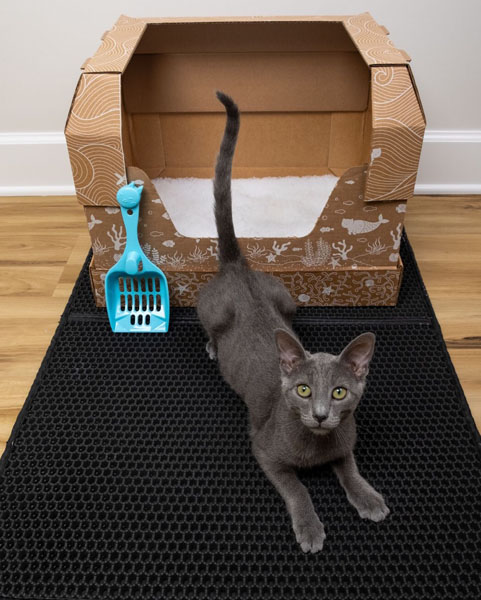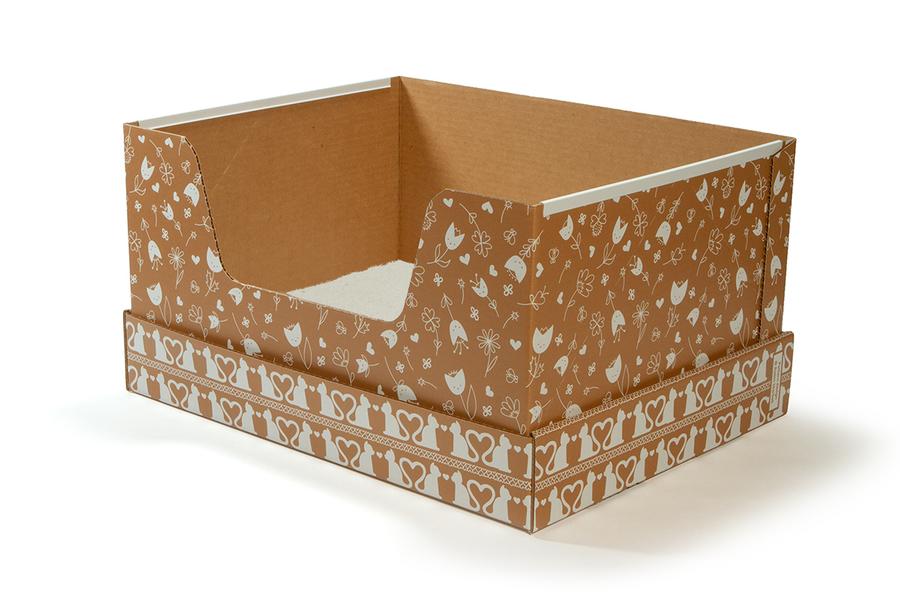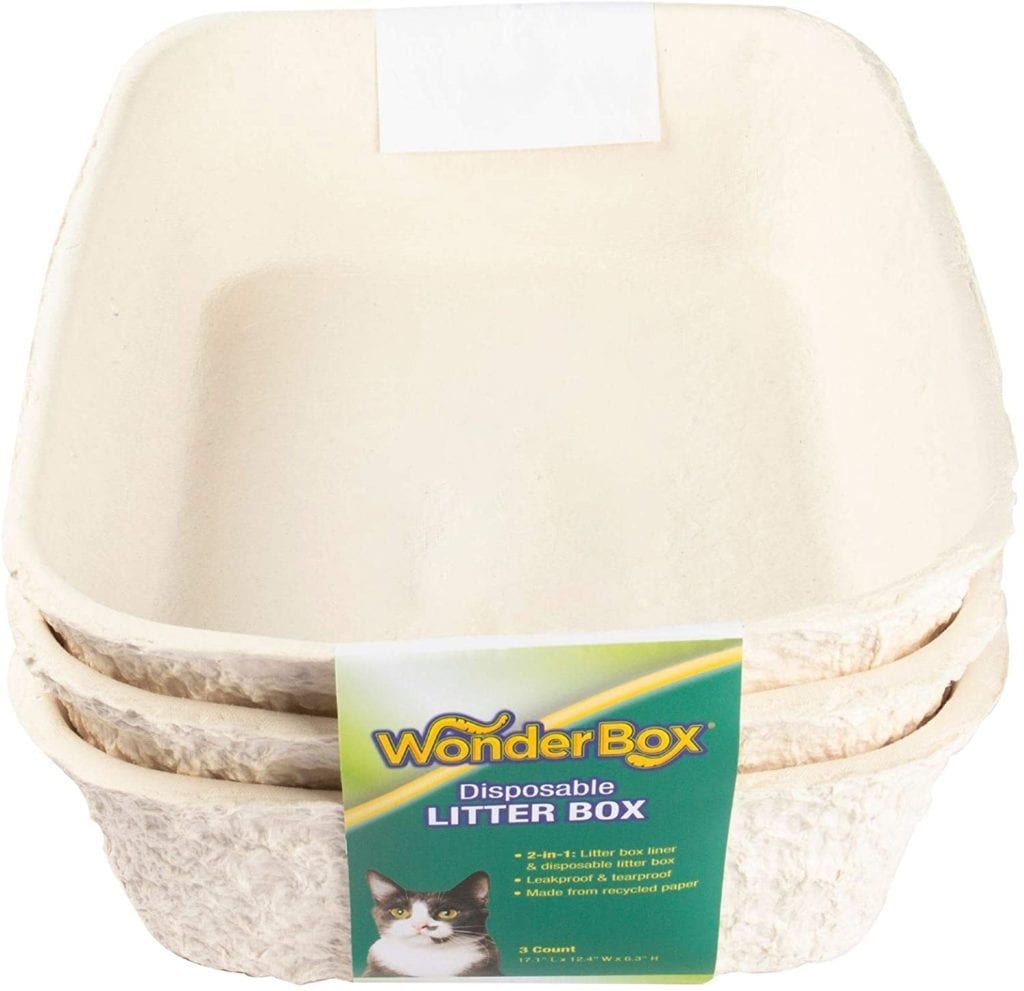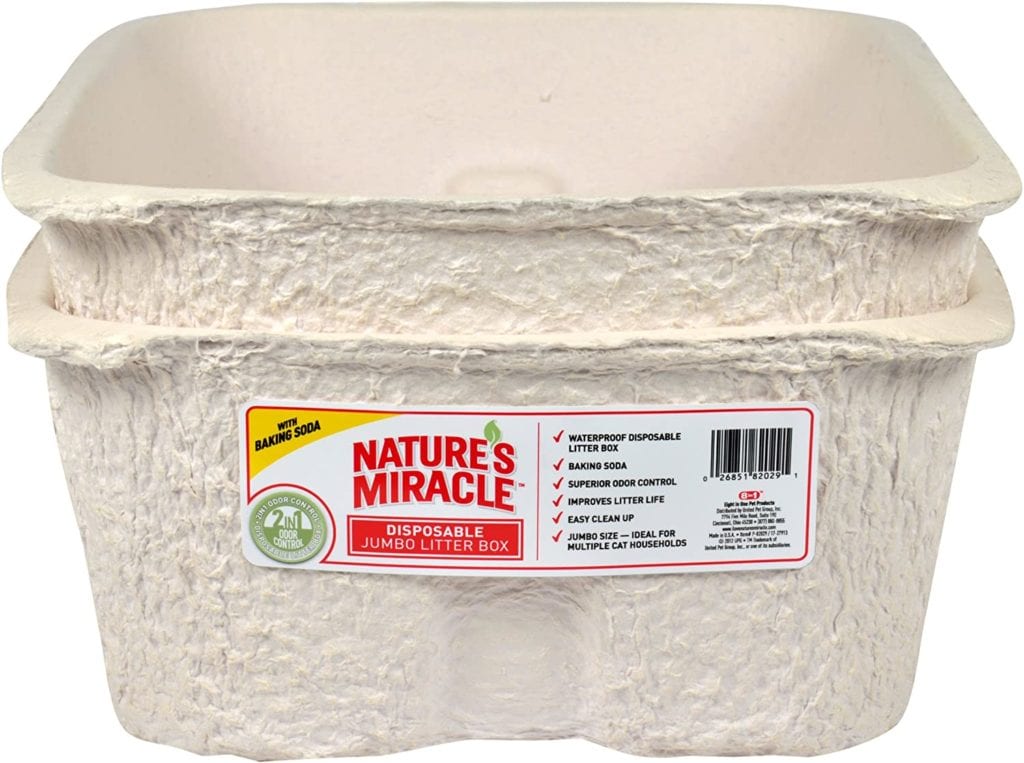Despite what the stereotype suggests, cats aren’t homebodies. They love getting out into the world! And with the advent of comfy harnesses and carriers, it’s a cinch to bring your favorite feline on an adventure with you. Well, with one tiny exception. Cats aren’t content with “wild” bathroom options the way dogs are. That means figuring out a way to lug their litter box around. Or you can go for the alternative of disposable litter boxes. If you compare the two side-by-side, one’s MUCH easier to deal with.
Disposable Litter Boxes
Disposable litter boxes are exactly what they sound like: a box you can toss into the trash without a second thought. Instead of the plastic of a conventional box, they’re made from biodegradable materials. This means they’ll break down when they fit a landfill. That’s good news for the environment. But it also helps out cat owners.
Plastic holds onto odors from urine and feces. This is why it’s important to practice routine cleaning of a box – about once a month. However, you can’t use strong cleaners or bleach due to the risk they pose to your cat. And, over time, that leads to more elbow grease for fewer results. With a box you can throw away? You simply trade out the old box for a new one.
Common Materials for Disposable Litter Boxes
The average disposable litter box lasts around a month (convenient!). But that “lifespan” depends on the materials.
- Cardboard: You can find two versions of the cardboard box: wax-coated and ordinary. A wax-coated box provides water resistance. That means it’ll last longer.
- Paper: Specifically, you’re looking at paper mache. These tend to be the most durable disposable litter boxes out there. They’re water-resistant, and some add baking soda into their mixture to provide extra odor control. Even better, the structure’s sound enough that you can cut into it to make adjustments if your cat needs a lower entry point.
- Plastic: Yeah, it sounds strange, but you WILL see an occasional recycled plastic box. They hold up against fluids without developing leaks, which people like. But, in the end, you’re dumping plastic back into the landfill.
Problems With Disposable Litter Boxes
While the chance to go green with your cat’s bathroom habits is always a good thing, you’ll find a few hiccups with disposable litter boxes. And the biggest relates to their construction.
Conventional plastic boxes endure your cat’s digging explorations. If your feline’s anything like the ones in our house, they go into a litter box with the enthusiasm of a child at the beach. Plastic can hold up against eager, digging claws. But cardboard and paper mache? They don’t do that well. This can mean tears in the bottom – and that leads to LEAKS.
The basic design on most paper mache disposable litter boxes also means you’ll find ridges and grooves from the molding process. Your cat won’t mind the design, but all of those tiny pockets can make cleaning a challenge for YOU. And while you CAN toss the box and get a new one, you probably don’t want to spend the money to do so every other week.
Uses for Disposable Litter Boxes
Obviously, disposable litter boxes are friends for the environment. And with cat owners following the “plus one” rule (always have ONE MORE litter box than the number of cats in the house), a biodegradable box keeps PLENTY of plastic from going to a landfill. But there’s more to these handy boxes than that eco-friendliness.
Travel
As hinted at before, they’re the perfect choice when you travel. Even if you use a traditional box at home, you probably don’t want to pack it into the car. (And automatic boxes? They don’t work very well without an outlet!) If you’re planning a lengthy road trip, the disposable option is the way to go. Your cat gets their bathroom, and you don’t have to fuss with a mess in the car.
Cat-Sitting
Maybe your kitty needs to stay with a friend. They don’t share a home with felines and lack supplies. Rather than carting hefty boxes over to their house, disposable litter boxes are a more practical way to go. (And your friends and family are more likely to accept a “temporary” option)
Health Monitoring
Then there are times when cats develop medical problems related to litter box issues. You may need to obtain samples for your vet. That gets tricky in multi-cat households. But if you set out a disposable litter box for the healthy kitties, you can leave the conventional boxes to gather the samples you need.
Choosing a Disposable Litter Box
Disposable litter boxes are NOT all created equal. Even if you’re picking one up for a quick jaunt with the family, you want to make sure you’re choosing a box that will hold up. (Soggy litter boxes in the car? That’s not fun) So you want to keep these features in mind:
- Materials: How long do you need that box to last? And how many cats will end up using it? Remember, paper mache is the most durable and water-resistant material.
- Size: As you would with any litter box, you need to make sure your cat fits nicely inside. Even if you’re trying to get it to “Tetris” into the car with the luggage.
- Design: Some disposable litter boxes have raised sides to prevent litter from getting scattered everywhere. That’s ideal when your favorite feline’s staying outside of their usual home. But it WILL trap odors inside, which cats aren’t impressed by.
- Litter: Some disposable litter boxes come with litter. And as long as your cat doesn’t mind, that’s fine. Otherwise, you want to choose a clumping or crystal litter to get the longest use out of the box.
Disposable NOT Recyclable
Once you’re ready to toss an old box, it’s crucial to remember that you have a DISPOSABLE litter box. While the materials are biodegradable (except for those random plastic boxes), you can’t put them out with your recycling. They need to go in the trash.
Cats can potentially carry bacteria and parasites in their feces – even if they never venture outdoors. Some of the biggest offenders include:
- Campylobacter
- Salmonella
- Toxoplasma gondii
All of these microbes? They’re zoonotic – meaning humans can end up infected. If the boxes go to a recycling plant, people may end up exposed at a higher rate than they would in a landfill.
If you want to make the biggest environmental impact? Combine your disposable box with flushable cat litter. Just keep both of them away from your recycle bins.
Best Disposable Litter Boxes
Whether you’re looking for a green solution for your home, need a handy travel option, or want to offer your friend an easy feline bathroom while they cat-sit, disposable litter boxes provide the answer. You’ll breathe easier knowing you’re not adding plastic to a landfill somewhere. And you won’t have to break your back trying to scrub out old odors from a box. Who doesn’t love a disposable option that DOESN’T create excess waste?
Kitty Poo Club is a handy subscription service that delivers your disposable litter box directly to your door each month. You don’t even have to pour the litter into the box – it’s already set up and ready to go! And it’s up to you what kind of litter you want to choose: fine-grain, silica crystals, or even an organic option. If you want, you can add extras such as a mat for the box to sit on, a litter scoop, or even toys and treats.
Downsides? The cardboard sides help wrangle kicked litter, but they’ll also hold in some of the odors. Not to mention they’re not water-resistant. Of course, you only need the box to last until your next order ships, so there’s some wiggle room. And if you choose the fine-grained or silica litters, they’re NOT clumping. You’ll want to watch for leaks.
The Good
- Cardboard
- Subscription delivers fresh box each month
- 4 litter options
- Can add extras to subscription
The Bad
- Cardboard not wax-coated
- High sides hold in odors
- Not all litters clumping
Want to get the most out of your purchase? Kitty’s Wonderbox includes options of up to SIX disposable litter boxes! The paper mache is durable and water-resistant while remaining sturdy – even if you need to make alterations. And the molding process smoothed out pesky ridges that can interfere with cleaning. You shouldn’t see issues with your cat tearing through the bottom, either – even if they try to dig to the center of the Earth.
The downsides? This box is on the small side. If you have more than one feline in the house, you’ll NEED six boxes to keep up. Some owners also felt it came out on the shallow side. That can pose problems for your little digger.
The Good
- Paper mache
- Available in up to 6-count option
- Smooth interior
The Bad
- Small size
- Shallow depth
Recognize the Nature’s Miracle name? They’re tops when it comes to taking care of pesky pet odors. And they made sure to mix baking soda into the paper mache of their disposable litter boxes for that very reason. You get two in a pack, with three sizes to choose from. (Though they ARE sturdy enough that you can cut them down) They’ll hold up well for a month with basic use, and then you can replace them.
So what are the downsides? These boxes come out on the pricier side. And because the inside has ridges, it makes cleaning a bit of a challenge.
The Good
- Paper mache
- Comes in 2-count package
- Available in 3 sizes
The Bad
- Expensive
- Difficult to clean
Disposable Culture
We’ve been conditioned NOT to throw so many things away. But in the case of disposable litter boxes, that’s the better option. Made of biodegradable materials, they’re safer than piling plastic boxes in the landfill all the time. And they provide a convenient solution when your cat needs to travel.
Just remember: they DO go in the trash. It’ll feel strange (and probably make you wince at first), but it’s the safest option. And it IS healthy – crazy as that sounds!









No comment yet, add your voice below!